August 24, 2007
Air Date: August 24, 2007
FULL SHOW
SEGMENTS
New Orleans: Lessons Not Learned
View the page for this story
Two years after Katrina, New Orleans and coastal Louisiana remain vulnerable to catastrophic flooding. Host Bruce Gellerman speaks with Time Magazine’s Michael Grunwald about progress not made and lessons not learned by Congress and the Army Corps of Engineers. (08:10)
The 11th Hour
View the page for this story
Tobin Hack, arts critic for Plenty Magazine, reviews the new film The 11th Hour. It’s Leonardo DiCaprio’s call to action on the environment, and it’s way more than a powerpoint for tree huggers. (03:30)
Fire Beneath Their Feet
/ Nilanjana BhowmickView the page for this story
All over the world there are fires in underground coalmines that have been burning for decades. Reporter Nilanjana Bhowmick reports from India's coal region on what it's like to live on ground that’s been spouting smoke and fire for 90 years. (07:52)
Solar Decathlon
View the page for this story
Host Bruce Gellerman visits MIT where students are putting the finishing touches on a solar-sufficient home. It’s the school’s entry in this year’s Solar Decathlon, sponsored by the Department of Energy. The homes in the contest must be built with off-the shelf technology that run entirely on solar energy. (09:48)
Children of the Amazon
View the page for this story
Filmmaker Denise Zmekhol talks with Bruce Gellerman about the Surui people of the Amazon, the subjects of her new PBS film “Children of the Amazon.” (14:08)
Music to Miss Moppet’s Ears
/ Jeff RiceView the page for this story
Damian Elias of Toronto University uses a laser Doppler vibrometer to record spider conversations. Producer Jeff Rice, of the Hearing Voices Project, visited with him to hear some of the good vibrations coming from the spider world. (03:33)
Show Credits and Funders
Show Transcript
HOST: Bruce Gellerman,
GUESTS: Michael Grunwald, Vasco Van RoosMalen, Almir Surui and Denise Zmekhol
REPORTER: Nilanjana Bhowmick, Damian Elias
SCIENCE NOTE: Amy Fish
COMMENTARY: Tobin Hack
[THEME]
GELLERMAN: From Public Radio International – It’s Living on Earth.
[THEME]
GELLERMAN: I’m Bruce Gellerman. Two years ago Hurricane Katrina struck with a vengeance, one of the greatest natural disasters in U.S. history but critics charge the catastrophe in New Orleans was a human failure.
GRUNWALD: What happened during Katrina was in many ways a tragedy of priorities. Everybody knew that wetlands are important, everybody knew that New Orleans was vulnerable, but it was never anybody’s top priority to make sure that this didn’t happen.
GELLERMAN: Also a living hell, life on top of a burning coal mine in India.
TRANSLATOR: I was cleaning the house when there was a crunching noise and the floor beneath me gave way. My feet went in and there was smoke all around.
GELLERMAN: And spider men seduce spider women with songs played on strands of silk. This week on Living on Earth. Stick around!
[THEME]
ANNOUNCER: Support for Living on Earth comes from the National Science Foundation and Stonyfield Farm.
New Orleans: Lessons Not Learned
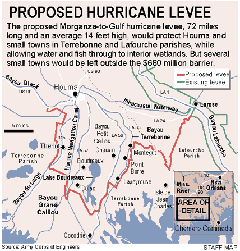
Proposed Levee (courtesy: Army Corps of Engineers)
GELLERMAN: From the Jennifer and Ted Stanley Studios in Somerville, Massachusetts – It’s Living on Earth. I’m Bruce Gellerman sitting in for Steve Curwood.
[SOUNDS OF POUNDING RAIN]
It was just two years ago August 29th 2005 Hurricane Katrina took aim on the Gulf Coast of the United States.
WOMAN: Wow this is the eyewall we’re in the eyewall. Oh my god look at that… look at the storm surge coming in!
GELLERMAN: Katrina was one of the most powerful, costly and deadly storms to strike the United States. The most severe loss of life was in New Orleans 80 percent of the city was under water. But much if not most of the deaths and destruction were due not to the natural disaster but human failure. There have been three major engineering investigations into the city’s catastrophe. They generally agree that the New Orleans’ system of levees were poorly designed and built by the Army Corps of Engineers.
But Michael Grunwald a senior correspondent for Time magazine who covered the Corps for the six years before Katrina struck goes even further. He says the Corps and Congress are directly responsible for the disaster.
GRUNWALD: You know I think after Hurricane Katrina the levees broke. It was a split second and nobody was watching. And then for a week we got to watch this paralyzed response and everybody saw that. But the fact is that if the levees hadn’t busted, you never would have heard the phrase “heck of a job, Brownie.” You never would have had the squalor in the Super Dome. If the levees had been designed and constructed properly and the Army Corps of Engineers had done its job, it really wouldn’t have been a big deal for the city.
GELLERMAN: Well, your story in Time Magazine really is a scathing indictment of the Corps and you write that the Corps is still a Corps of engineers and not a Corps of ecologists. What do you mean by that?
GRUNWALD: Well the Army Corps is a strange beast. It began building fortifications at Bunker Hill in George Washington’s revolutionary army. But it’s really sort of it’s best known and what has been its bread and butter is sort of damming and diking rivers, pouring sand onto beaches. Essentially they’ve been the shock troops in America’s war against nature. And now we’re counting on them to build sustainably to help restore some of the mistakes they’ve made in the past. But still they’re engineers. Their motto is essayons, “let us try.” They still like to move dirt and pour concrete.

Proposed Levee (courtesy: Army Corps of Engineers)
GELLERMAN: But haven’t they made any progress towards freeing up the Mississippi, you know sediments, building up land, coastal protection?
GRUNWALD: No, they really haven’t. Over the years they’ve reduced the sediment load that’s coming down the Mississippi River by more than half. And that sediment essentially is how southern Louisiana was built, from the Mississippi River. New Orleans was built on a natural levee, sediment deposited by the river. And it created 7,000 square miles of coastal wetlands that used to provide this natural buffer that separated New Orleans from the Gulf. And as the Army Corps sort of throttled that river and man handled it into a ditch and has really stopped that natural land building process, you have the city starting to sink. That’s why it’s a city in a bowl below sea level instead of sitting up high on a natural levee. And those coastal wetlands have started to disappear. And that’s what really left New Orleans so exposed. New Orleans was not originally a coastal city. It was an inland city. But the fact is the Gulf has now moved about 20 miles closer to the city. And some scientists are saying that in 10 years it’s going to be at the New Orleans suburbs.
GELLERMAN: Well, in one of your most recent articles actually you sight an LSU hydraulic engineer who points out that about 100 yards of cyprus trees can reduce the wave action there by about 95 percent. If scientists understand what needs to be done on the Gulf Coast why isn’t that work well underway at this point?
GRUNWALD: Yeah, that’s uh what happened in Hurricane Katrina was in many ways a tragedy of priorities. Everybody knew that wetlands are important. Everybody knew that New Orleans was vulnerable. But it was never anybody’s top priority to make sure that this didn’t happen. So that’s why you have Louisiana’s Congressional Delegation at a time when they never could get the Corps to build a decent levee for New Orleans. They never really did get a decent restoration program going for those coastal wetlands. You had these incredible boondoggles that were still getting funded like the Mississippi River Gulf Outlet which is supposed to provide a shipping shortcut to the port of New Orleans but actually ended up increasing Katrina’s surge and contributing to the disaster. So, again the Corps is this strange beast that’s controlled by Congress. You hear a lot about these earmarks and the entire Corps budget almost is controlled by these Congressional earmarks. It’s pet projects. And the pet projects were not the projects that made New Orleans safe.
GELLERMAN: So, improper influence, political influence, influencing the setting of priorities.
GRUNWALD: Well, what the Corps would say, and there’s some fairness to it, is that they reflect America’s priorities and that America never made it a top priority. I think it’s not entirely true because first of all the Army Corps has a lot of influence on what it gets to do. And it doesn’t do anything until it says, “hey this is a justified project.” But the fact is America never stood up and said, “Our top priority is to make sure that New Orleans is never drowned by even a moderate hurricane.” And unfortunately we still haven’t really said that. So far there’s been seven billion dollars appropriated for the Corps down there. Just chicken change has gone for any rebuilding of wetlands. It’s still going to take another four years for the Corps just to provide protection from what they say is a 100-year storm. And these 100-year storms seem to be coming every few years now. So the city is still extremely vulnerable and the work is going pretty slow.
GELLERMAN: So, you don’t sound like there’s any chance for things to go right.
GRUNWALD: Well, I wouldn’t say that. Maybe I’m just the perpetual optimist. When you’re talking to scientists, I don’t want to understate the difficulty of the challenge, but they say that they know what they need to do and it can be done. It’s just a question of getting the Corps and Congress to do it. Eventually you want to stop building levees across marshes. You want to stop promoting development in the most flood prone areas. And you want to start trying to get that sediment down to the Gulf. Unfortunately right now Congress is about to approve the first sort of set of post-Katrina projects. And the big one does exactly the opposite. It’s another billion-dollar levee through marshes. They’re starting to call it the Great Wall of Louisiana. This is to protect these isolated coastal towns that you’ve never heard of with names like Dulac, and Chauvin, and Montegut. These are places that may already be doomed and by building them these 15 million dollar-a-mile levees you’re essentially telling people don’t elevate your houses. Don’t move to higher ground. The government’s going to take care of you. And it suggests that the lessons of Katrina have not been learned.
GELLERMAN: Michael thank you very much.
GRUNWALD: Thanks so much for having me.
GELLERMAN: Michael Grunwald is a Senior Correspondent for Time magazine.
[MUSIC: Christian Scott: Katrina’s Eyes “Anthem” (Concord 2007)]
Related links:
- Michael Grunwald’s feature article in Time Magazine
- A Blog from the Times-Picayune of New Orleans on the state of the levees:
- South Louisiana’s Environmental Network
The 11th Hour
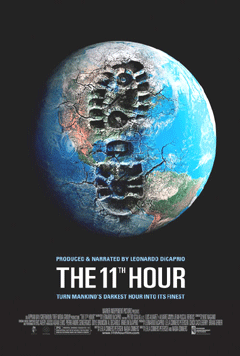
(courtesy: 11thhouraction.com)
GELLERMAN: Actor Leonardo DiCaprio has been nominated for three Oscars for his performance in blockbuster films including: Blood Diamond and The Aviator. But perhaps DiCaprio’s most powerful role may be his latest, which involves virtually no acting at all.
DICAPRIO: The evidence is now clear. Industrial civilization has caused irreparable damage. Our political and corporate leaders have consistently ignored the overwhelming scientific evidence.
MAN’S VOICE: Not only is it the 11th Hour It’s 11:59.
GELLERMAN: Leonardo DiCaprio is the narrator of the new film “The 11th Hour”. The documentary ---which he also produced---deals with, what DiCaprio calls, a convergence of environmental crises. The 11th Hour, opens this week in theaters across the county.

Could you refuse that face? Leonardo DiCaprio narrated and produced the film, the 11th Hour. (courtesy: www.11thhouraction.com)
Tobin Hack has our review.
HACK: For the first time since Titanic, Leonardo DiCaprio is not the star of his latest film. In fact, he’s rarely on screen in his new environment crisis documentary, the 11th Hour. DiCaprio’s a mouthpiece here, lending his larger-than-life name to a cause he’s clearly passionate about.
The limelight falls instead on a barrage of more than 50 big-name scientists, academics, entrepreneurs, religious leaders, politicians, and more. This strength-in-numbers approach means that no matter what your background or interests, there is something in this film for you.
If business is your thing, or you’re concerned about national security, James Woolsey (Booz Allen VP and former CIA director) talks to you about the implications of dependence on oil. If someone you care about is fighting serious illness, endocrinologist Theo Colborn will tell you about the connections between chemicals we use every day and rising rates of cancers, Parkinson’s, and Alzheimer’s.

(courtesy: 11thhouraction.com)
In need of numbers and hard evidence? Activist Bill McKibben explains that 20 percent of all arctic ice has melted, and the speed and duration of hurricanes has increased by 50 percent.
In other words, no matter who you are, to ignore the film’s message simply won’t be an option, once you’ve paid your ten bucks and settled into your seat.
DiCaprio could have been a little less academic in his appeals. He’s a little too good, too grammatically correct, too conscious of the fact that he’s narrating a documentary instead of playing a role in a blockbuster. He’s not an investigative reporter, after all, but one of today’s most intelligent, conscientious, and talented actors. He’s in a powerful position to speak to the millions of Americans who don’t compost yet, but who flocked to theaters for Catch Me If You Can - and kudos to him for stepping up to the plate.
The 11th Hour administers a healthy dose of Katrina, and hits all the biggies (global warming, deforestation, overfishing, Big Oil, health issues), but its tone is solution-oriented, and its social commentary fearless. It doesn’t stop at “What’s wrong with the earth?” but asks what’s wrong with us—our relationship with nature and with ourselves. And it pulls no punches. We’re greedy consumers, we’re lost, we’re an infection on the earth, we’re pursuing happiness in all the wrong ways and writing our own death sentence in the process. But for every “down with people” sentiment expressed in the film, a note of hope is offered up as well. As author Paul Hawken reminds us, “The great thing about this age is that we get to re-imagine every single thing that we do.” If this is in fact the 11th hour, then it’s also “a great time to be alive, because this generation gets to completely change this world.”
GELLERMAN: The film is The 11th Hour. Our Reviewer Tobin Hack is the Arts Critic for Plenty magazine and a former producer here at Living on Earth.
[MUSIC: Christian Scott “Litany Of Fear” (Concord 2007)]
Related links:
- http://wip.warnerbros.com/11thhour/
- Take the 11th Hour Challenge
- Plenty Magazine
GELLERMAN: Coming up living above an inferno in India - hell on earth atop a coal fire. That’s just ahead on Living on Earth.
Fire Beneath Their Feet

(courtesy: Minerals, Mines and People)
GELLERMAN: This is Living on Earth, I’m Bruce Gellerman. Working in coalmines is a dirty, dangerous, too often, deadly occupation.
In Utah, authorities have given up hope for the six miners trapped by the collapse at the Crandall Canyon Mine. Three rescuers were also killed there trying to reach the men…and In China, almost 200 miners died this month after torrential rains flooded two coalmines there. Living near coalmines can also be dangerous.
Today we continue our series Generating Controversy: the Changing Climate of Coal with a visit to Jharia, in eastern India’s coal country where an underground coal fire has been smoldering for almost 100 years.
As reporter Nilanjana Bhowmick tells us, residents of Jharia say that life above the fire is a living hell.
[CLEANING SOUNDS]
[RANI DEVI SPEAKING IN BENGALI WITH ENGLISH TRANSLATION]
TRANSLATOR: I was cleaning the house when there was a crunching noise and the floor beneath me gave way. My feet went in and there was smoke all around.
[GOUR KARMAKER SPEAKING IN BENGALI]
TRANSLATOR: The floor dropped down by six feet almost. I had to pour 200 gallons of water, 50 bags of sand and 40 bags of gravel to repair the damage. If we were sleeping that night, we all would all have either choked or burnt to death.
BHOWMICK: Rani Devi and Gour Karmakar are a middle-aged couple who live in the village of Kumarabasti, the potter’s village, half an hour from the coal-mining town of Jharia. What collapsed the floor of their home that day was a mine fire that’s been slowly spreading in the area for 90 years, since 1916.

(courtesy: Minerals, Mines and People)
[WOMEN SPEAKING IN BENGALI]
TRANSLATOR: Because of the fire we stay outside with our children during the daytime and return only at nightfall. They have asked us to vacate this place and go but where will we go? This is the potters village and our livelihood is pottery. If we leave our livelihood we have nothing.
BHOWMICK: The potters actually use the roasted soil here in their work. There is also work in the mines. Mines that have active fires burning are closed. But others mines nearby are operating. Workers walk toward the elevators that take them underground to their shifts. They walk against a backdrop of smoke. Orange flames poke out from places where the rock glows red.
People here say what they fear most is losing a family member to a floor collapse, like the one at Rani Devi and Gour Kamakar’s home. But an outsider can’t help but notice another threat - the poisonous gases. People are sick. The children are most affected.
[SHANKAR MAHATO SPEAKING IN BENGALI]
TRANSLATOR: You see my son? He has been suffering since he was only one and a half months old. He had asthma ever since he was born. What can we do? We are poor people. We have accepted this as our fate.
BHOWMICK: Shankar Mahato lives in one of the villages over the fire. He sits at a medical clinic with his 18-month-old. He says his son has been diagnosed with pneumonia, asthma, and tuberculosis in his short life. Around us, people waiting to see the doctor look worn out. Most of them are coughing badly. Dr. Rajiv Agarwal, who has been practicing in the area for the last 20 years, explains how the gases affect people’s health.
[DR AGARWAL IN BENGALI AND ENGLISH]
TRANSLATOR: I mostly treat patients with tuberculosis, bronchial asthma. The damage is irreversible. Gases like carbon monoxide and methane hamper proper growth of children in this area.
BHOWMICK: The raging fires in the coalmines not only render the air unsuitable for breathing but also bring other practical problems. The only river that used to be a source of fresh water for the inhabitants of these villages has dried up and at best, produces some contaminated water. Jhuma Mahato and Kajri Billo:
[JHUMA MAHATO AND KAJRI BILLO IN BENGALI]
TRANSLATOR: We have to travel to Jharia town which is one and a half mile away from here. We go walking and bring the water back. People fight for just a bit of water. It is very tiring and troublesome.
BHOWMICK: The coalmines of this district are mostly owned by Bharat Coking Coal Limited, a subsidiary of India’s state-owned coal company. The coal fires are costing money, about 650 million dollars in lost high-grade coking coal so far.
That may be why Indian President APJ Abdul Kalam recently ordered the Indian Coal ministry to find a solution, and quickly. But quenching coal fires is difficult and often unsuccessful.
As for the people here, the government has come up with a plan to move the mainly government workers who live in Jharia town. But there are no such plans for the poorer people of the surrounding villages. The government calls them “encroachers,” and claims they don’t have the residence papers required of everyone in India. The villagers have just been asked to vacate the area and move to safer zones. District magistrate Bila Rajesh:
RAJESH: It is a chronic problem, in fact. The fire has been raging for nearly 100 years. It is definitely a very sensitive issue and it needs to be addressed urgently. People were under the impression that perhaps the fire should be controlled and people should not have to shift out from the place. Because they’ve been living there for generations, so they find it very difficult to think that why, “if our parents have lived here, if the past few generations have lived here, why not us as well?”
BHOWMICK: It’s true, many residents of the area say they prefer to stay. Swaroop Mondal is a member of the Save Jharia Organisation.
[SWAROOP MONDAL IN BENGALI]
TRANSLATOR: This is a historic city. It had agriculture, and some of the lowest food prices in the country, that’s even true today. Such a huge market will be destroyed – it’s just unthinkable.
BHOWMICK: India’s Coal Secretary, Prakash Chandra Parekh, however, claims residents are willing to relocate.
PAREKH: I went in the morning to one of those sites. There is not one person who said that he has any problem. They said “yes, as soon as you make it available, another place, we’ll move out of there.”
[MASALA GRINDING ON STONE, SOUND OF UTENSILS AND PEOPLE]
BHOWMICK: In the evening, women set out mud ovens and prepare dinner. Little girls are entrusted with kneading the dough for the chapati while their mothers grind spices. The men folk smoke and chat outside, sitting on beds of woven rope. At a glance, a normal village scenario. The only difference is that in most of India, people do these activities inside their homes. Here they do them outside, because at any moment the raging fire underneath could engulf them.
For Living On Earth, I’m Nilanjana Bhowmick, in Jharia, eastern India.
[MUSIC: Nusrat Fatah Ali Khan: “Mangte Hain Karam” Platinum Collection]
Related links:
- Dr. Anupma Prakash’s coal fire website
- American Geological Institute
Solar Decathlon
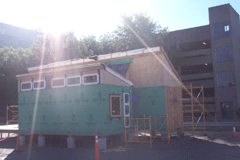
The contender, shining in the sun. (courtesy Bruce Gellerman)
GELLERMAN: This week in Washington, well actually not much happened. It’s late August after all. Congress is on vacation, the President is on vacation, even our own Washington correspondent Jeff Young is on vacation. So, at least on this program you’ll hear no news this week out of Washington. Instead here’s a story closer to home about some people working hard to get to Washington.
[DRILL SOUNDS]
GELLERMAN: There’s a fenced in parking lot on the campus of the Massachusetts Institute of Technology that looks like a scene out of the TV series MASH. There’s a metal Quansat hut, a sign pointing the way to distant places, and in the air a sense of improv and irreverence. In fact on the MIT campus here in Cambridge they call this place MASH. It stands for Modern All Solar House.
MIT is one of 20 teams of college and universities students competing in the Department of Energy’s Solar Decathlon. It challenges students to construct houses powered entirely by the sun. It means squeezing every watt of energy from the solar homes they built. And like the show MASH rules are, well, creatively flexible.
DECOLA: My name is Jonah DeCola and I’m a construction manager and I’ve been brought in to help the Solar Decathlon team sort out all the chaos of this new technology.
GELLERMAN: Are you an MIT student?
DECOLA: No, I’m not. I’m a freelance construction manager.
GELLERMAN: You’re a ringer!
DECOLA: I’m a ringer, yes.
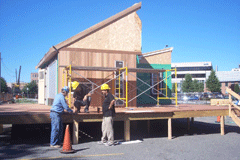
L-R) Jonah DeCola, Hugo Lukacs, and Kurt Keville working on their decathlon entry.
GELLERMAN: Is that allowed by the rules?
DECOLA: For support, absolutely. Sure. To consult with experts.
GELLERMAN: Have you ever built anything like this house?
DECOLA: Green affordable housing has been a passion of mine. I’ve been doing some projects in Boston for a number of years. So, bringing this technology to market is the key. And so how is that transition going to happen without folks being able to familiarize themselves with the products so that it has a seamless transition. What we’re facing as far as the future green building, in practical, terms is the ability to bring this technology to market.
[SAWING SOUNDS]
GELLERMAN: The Solar Decathlon requires teams to use off-the-shelf products in new and creative ways. The idea: to demonstrate solar energy is technically and economically feasible today.
[DRILL SOUNDS]
GELLERMAN: MIT students have been building their house since spring. It’s almost done but almost as soon as it’s finished they’ll have to take it apart, truck it to Washington DC and re-assemble it on the National Mall where the 20 solar decathlon homes will be judged in 10 contests just like the Olympic decathlon.
The categories include architecture, livability, comfort, appliances, and hot water production. The solar self-sufficient homes even have to power an electric car using energy produced only by the house.
Kurt Keville, the principle investigator for MIT’s entry in the Solar Decathlon details the rules:
KEVILLE: So, the competition favors a levalized energy analysis for your locale.
GELLERMAN: You sound like somebody who’s from MIT.
KEVILLE: Ok, sorry. You have to build a 800 square foot house that’s completely off grid. You have to power a car as well as all of your appliances: washer, dryer, stove etc., off of any energy that you generate from the sun.
GELLERMAN: Ok, so let’s take a tour.
KEVILLE: Sure.
[TRAFFIC SOUNDS]
KEVILLE: Ok, we’re walking up a flight of stairs, we’re simulating where we’re going to be on the mall with stilts. On the mall we’re not allowed to dig into the ground so we’re building it on diamond pier pin foundations.
GELLERMAN: Now, I noticed that you’re not using that white stuff that they usually put on the outside of houses before they put on the finish. You’ve got this green guard. What is that?
KEVILLE: That’s right. This is a new style of house wrap that actually wicks the water, if you look on the inside of this material it actually wicks the water from the top to the bottom. It’s got this nice sort of plastic capillary system that brings the water down. This will keep our OSB, our plywood good and dry.
GELLERMAN: OSB?
KEVILLE: OSB, yeah it’s the plywood that’s on the outside of our structural insulated panels. I think you can see on that gap there, a sip is two pieces of plywood separated by six, eight or ten inches of polystyrene, of styrofoam. And it turns out that’s a really good way to not only get high thermal R values but it’s also quite light. It’s very easy to work with. I mean all these walls were put up with basically two man lifts and we just clicked them together like legos.
GELLERMAN: And you’re going to unclick them to get them to Washington.
KEVILLE: That’s right, yeah. That’s another thing we would do differently. We use screws in this house rather than nails because we’re going to have to disassemble it, reassemble it and then one more disassemble-reassemble, at the end of the competition.
GELLERMAN: Now how efficient is this house going to be?
KEVILLE: Well, that’s where we think we’re going to make our bones. We have a really good, you can see how the light is falling right now, we have a really good way to capture day lighting so we won’t have to turn the house lights on at all during the day. We also have a fairly innovative cross flow of air. We got windows down low to bring in cold air on the cold side of the house and windows up high to blow it out. We’ve got skylights and clear story windows up in our eaves here to carry the air through and that will give us some good natural convection.

The contender, shining in the sun. (courtesy Bruce Gellerman)
GELLERMAN: Now, this is New England. It gets cold.
KEVILLE: That’s right.
GELLERMAN: Now, those walls look like standard sized walls. Anything special in the walls?
KEVILLE: These sips are rated quite highly. We uh, we can specify the thickness of a sip. Our roof, the structurally insulated panels on the roof are a couple more inches thick than our walls. We think we’re going to have plenty of heat in the house so our walls are six inches thick and our roof is ten inches.
GELLERMAN: What’s the R value then in the walls?
KEVILLE: Twenty-seven for the walls. Now that’s pretty good. We also have really, really high-end triple pane krypton gas separated windows. And those are R values about 15 to 17.
GELLERMAN: Wow
KEVILLE: Yeah.
GELLERMAN: What about this big window? It looks like, I don’t know, it must be ten feet by four feet, five feet high?
KEVILLE: That’s right. We’re calling that our warm light wall.
GELLERMAN: But it looks unlike any window I’ve ever seen.
KEVILLE: That’s right. It’s an innovative tile design. Each one of those tiles has a couple pints of water in it as well as a thin layer of aerogel.
GELLERMAN: Aerogel?
KEVILLE: Aerogel, yeah. Aerogel is a very very thermally insulated material developed at Cabot Corporation. Very light, easy to handle, and it lets light go through it. That was one of our key things here, is to let the visible spectrum come through the wall and it will take all the infrared and the UV out. So you’ve got a very good thermal barrier on the exterior of the house and I’m very interested to see what this house does in January. We’ve done calculations so that this house will be net energy positive year round. And January is going to be our big test I think.
GELLERMAN: Net energy positive meaning that it will generate more energy than it needs and it will put it back into the grid.
KEVILLE: That’s right. In January we’ll have to dial down our usage but I think we’re going to be wildly net positive this month and next.
GELLERMAN: What is it going to cost you to build this house?
KEVILLE: Well, we are tracking both our real costs and our retail costs. We’ve gotten quite a bit of financial sponsorship with this. So, to that extent this is probably a $250,000 house, which is a lot for 800 square feet, but we’re generating probably twice the amount of electricity you would generate if you were actually building a 800 square foot house.
GELLERMAN: One bedroom.
KEVILLE: One bedroom. One office. This section here is a long kitchen/dining room section. That wall there is the bathroom and utility room in the very back.
GELLERMAN: What’s the prize?
KEVILLE: Bragging rights. The history of this competition is there’ve been two previous competitions, alternating years, odd years and Colorado’s won both of them. Colorado is far and a way the team to beat.
GELLERMAN: Do you have any spies out in Colorado watching what they’re doing?
KEVILLE: No, kind of the opposite we have people coming back to graduate school at MIT that have participated in previous years on other teams and that kind of experience is invaluable to us.
GELLERMAN: MIT’s Kurt Keville. In a sense you could be a winner in the Solar Decathlon because many of the construction materials and methods demonstrated in the contest could be used to build an energy efficient home in your future. This year’s Solar Decathlon promises to be close.
[MUSIC: Johnny Mandel/Bob James. Theme from M.A.S.H. from the soundtrack to the film M.A.S.H.]
GELLERMAN: There’s only so much innovation you can jam into one small house. But by one measure MIT’s entry is unique. It’s measured in Smoots. The Smoot is named for Oliver Smoot, MIT class of ’62. As a freshman his fraternity brothers initiated him by turning him head over heals to measure a bridge connecting MIT to Boston. One Smoot equals 5 feet 7 inches. Making MIT’s MASH, Modern All Solar House, about 47 square Smoots, give or take a square here.
For pictures and more information about the Solar Decathlon check out our Web site: loe dot org.
Related links:
- Solar Decathlon Website
- MIT's Solar Decathlon Website
Children of the Amazon
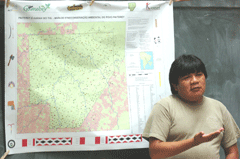
Chief Almir Surui explains one of the cultural maps made by members of his community with the help of the Amazon Conservation Team. (Courtesy of Amazon Conservation Team)
GELLERMAN: It’s Living on Earth. I’m Bruce Gellerman.
[BIRDS IN FOREST]
GELLERMAN: This is the sound of the Amazon rainforest. It’s one of the richest places on the planet for plants and wildlife and home to scores of remote indigenous tribes. The forest is also one of the most important places in the world for regulating carbon dioxide in the atmosphere.
[CHAIN SAWS AND TREE FALLS]
GELLERMAN: This too is the sound of the Amazon. Chainsaws and bulldozers have been carving away at the rainforest for decades clearing land for highways, cattle ranches and soybean plantations. It’s estimated that nearly 20 percent of the Amazon has been cleared, including an area almost the size of New Hampshire just last year.
Much of the destruction of the Amazon forest has taken place on the territory of indigenous tribes. In just a few brief years, members of many of these isolated societies were wrenched from the stone age into the space age… some driven nearly to extinction by their first contact with the outside world.
Almost 20 years ago, Denise Zmekhol traveled deep into the Amazon to photograph and document their struggles. She recently returned with a film crew to examine the changes the people of the rainforest have gone through since her first visit. Her new film is called “Children of the Amazon.”
It focuses on one tribe in particular: the Surui. Denise Zmekhol says the Surui never had contact with the outside world until the roads we built.
ZMEKHOL: The first official contact happened in 1969 when they were still living in what I call in the film “forest time.” It’s a very recent contact and I think they had to learn a lot about our society and our world in such a small time. So for thousands of years they were living in one way and just 39 years ago everything changed for them. So, yeah it’s pretty recent.
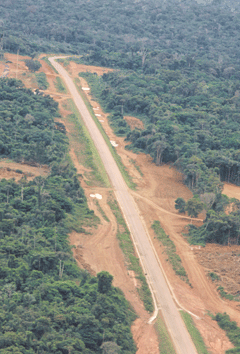
Highway BR364 was built through the heart of Surui territory. It brought an agricultural boom to Brazil but death and disease to indigenous groups. (Courtesy of Denise Zmekhol)
ZMEKHOL: Well, it’s a concept that we kind of use in the film when we interview one of the Surui girls and she mentions this term “tempo de floresta.” It was the time they were living by themselves isolated from settlers and loggers, hunting and fishing. So, that’s to me what’s forest time, when they were living in their ways.
GELLERMAN: And then things change very dramatically in 1969, the Brazilian government and the World Bank team up to build this road right through the heart of Surui territory and there’s a section in your film about that development.
[DOCUMENTARY MUSIC PORTUGUESE AND THEN ENGLISH TRANSLATION]
DOCUMENTARY: It is not enough to build roads. We must colonize for agriculture or for cattle. The land is good. There are green pastures in the forest made of milk and honey.
ZMEKHOL: That’s when I was growing up and they were building these roads in the Amazon. The military government was really thinking of the best solution for the Amazon was to develop and bring people from other parts of Brazil who had no land to farm. So they were trying to solve all kinds of problems and they thought it was a great idea at that time to do it, but they had no idea that the impact was going to be so huge and destructive.
GELLERMAN: The road brings people and settlers and the Surui are a warrior tribe but they can’t fight off these people and they certainly can’t fight off the diseases that the settlers bring.
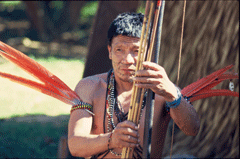
Photo of a Sururi warrior taken in 1987. (Courtesy of Denise Zmekhol)
GELLERMAN: The diseases kill off most of the elders. The culture is decimated. The oral traditions are almost lost.
ZMEKHOL: Yes, because they don’t have a written language. They don’t use writing so everything is passed on from one generation to another. So, the elders die it’s like loosing encyclopedia of traditions and customs. They really don’t have any reference, any way to keep teaching the new generations.
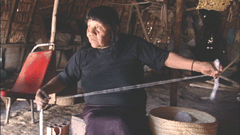
Almir’s mother was one of the few elders that survived the diseases brought by Westerners from the first contact. (Courtesy of Denise Zmekhol)
ZMEKHOL: Yes, well Chico Mendes his story is that his family came to harvest rubber I would say maybe 100 years ago. He was born in the forest and he was a rubber tapper and his father was a rubber tapper. He was part of the forest and he knew how important it was to keep all those forests standing and he got a passport and flew to the United States and did a lot of lobbying and he was heard.
[VILLAGE SOUNDS]
ZMEKHOL: In this scene he was being interviewed in his window and he was holding his son Sandino who was at that time two years old.
[CHICO MENDES SPEAKS POTUGUESE WITH ENGLISH OVER IT]
TRANSLATOR: After my trip to the United States political pressure was put on the international banks that were largely responsible for the devastation of the Amazon because of the projects they funded.
ZMEKHOL: He was talking about serious stuff and how his trip to the U.S. had really made a difference you know and had created a lot of pressure and things were changing.
[MENDES IN POTUGUESE THEN ENGLISH]
TRANSLATOR: Projects which had the false slogan of Amazonian development but were a disaster.
ZMEKHOL: And Sandino was just playing and looking at us, and making those nice sounds. So it’s a very beautiful image.
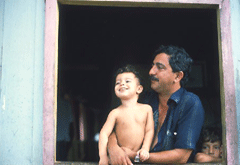
Chico Mendes and his son Sandino one month before Chico’s assassination. (Courtesy of Denise Zmekhol)
ZMEKHOL: Yeah, and it’s a very sad chapter of that story because he was fighting with big forces you know, big economic forces. He was calling attention, international attention, to the Amazon. And I think one year after he was here the financing of the paving of the road in his state was suspended. And that’s when a lot of ranchers and politicians got really mad at him. But he was very brave. You know he really felt that it was an important thing to do and he went for it.
GELLERMAN: He asked you to film his funeral. He knew he was going to die.
ZMEKHOL: Yeah, he knew and just being around him one month before his assassination you could tell that it could happen any time. It was very tense. And he had already two bodyguards following him around but it wasn’t enough to stop the murders. But the thing is it’s a landless, sorry a lawless world. It’s the last frontier, people kill each other no matter what. You know it’s so hard everything. The police are so corrupt. It’s so complicated, so complex.
GELLERMAN: Have you ever been threatened while working there?
ZMEKHOL: No, but I have felt a little uncomfortable interviewing some people. I remember one of the people that I felt the most uncomfortable was one of the ranchers in the state of Acre where Chico’s from. We knew he was part of this group of ranchers who really wanted to get rid of Chico and he was involved in Chico’s assassination. We went to do an interview with him. And we just left the interview feeling like oh my God maybe there’s a bomb under our car or someone is going to shoot us. We just felt like anything can happen you know.
GELLERMAN: You know Denise, it’s interesting. I had a recent opportunity to talk to someone who’s in your film, Almir Surui, He’s now a tribal leader. He was the first one in the tribe to go to college. When I spoke with him he was along with Vasco Van Roosmalen from the Amazon Conservation Team and I guess they were touring the United States. But when I spoke with Almir he told me how dangerous it is to live in his area.
[ALMIR SPEAKS PORTUGUESE AND VASCO TRANSLATES]
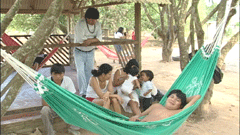
Chief Almir Surui and his family (Courtesy of Denise Zmekhol)
VAN ROOSMALEN: And here I would like to include a side note, is that they are living in a real frontier area where people truly believe that development is deforestation. But the only time Almir ever considered selling logs was when his adopted daughter hadn’t eaten in two days, hadn’t been able to drink milk. And when she was crying at home he looked at her and he says and thought to himself, “why don’t I just sell out?” And he ended up not doing it. It’s not as if these people are sitting in a very comfortable position. Their cultures are being taken away. They don’t have many economic options that are being supported.
GELLERMAN: So, Denise, what are the economic options for these people?
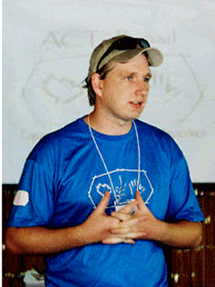
Vasco Van Roosmalen, director of the Brazil program for Amazon Conservation Team (Courtesy of Amazon Conservation Team)
GELLERMAN: And they’re using new technologies. When I spoke with Vasco he told me about the Amazon Conservation Team’s project to help map the area. They never had maps and they’re creating these not just geographic maps but cultural maps. Let’s listen to a little of that conversation.
VAN ROOSMALEN: They have so much knowledge of their territory it’s really just opening the door to them and giving them very basic tools, GPS devices. It’s just sitting them down with the right experts for a week and when they come out they become expert mappers. And I have seen indigenous mappers draw in freehand creeks onto a base map and then we’ve overlayed them just for fun with satellite pictures and they were completely correct. And you can see that as he’s drawing it he’s back in his canoe going right and left and right and left. It’s amazing their ability and their connection to the land.

Chief Almir Surui explains one of the cultural maps made by members of his community with the help of the Amazon Conservation Team. (Courtesy of Amazon Conservation Team)
ZMEKHOL: Oh, that’s beautiful you know it’s exactly how I you know, we can’t disconnect them from their land. It’s a vital part of their everyday life. There is no separation between the tradition, the harvesting, the hunting. Everything is so integrated to the forest.
GELLERMAN: But do you think making a map will help these people preserve their culture and defend their territory?
ZMEKHOL: Well, I hope so. They have to try anything to protect their land and their territory because it’s really a hard battle there. It’s like the last frontier, it’s the same feeling, it’s like the Wild West of Brazil. It’s completely out of control.
GELLERMAN: Well, when I talked with Almir he didn’t sound like he was ever going to give up on this cause.
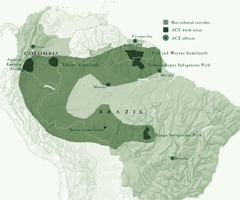
Map of Brazil which shows the extent of indigenous lands and the location of the Surui homelands. (Courtesy of Amazon Conservation Team)
GELLERMAN: Well, he says he’s not a hero but he told me he’s not backing down.
[VASCO TRANSLATES FOR ALMIR]
TRANSLATOR: I haven’t sold out because I want the future of my people and of humanity and of the entire world. If we give up our struggle what will be the future of the world? What will be the future of the Surui people, what will be the future of the American people, or the rest of the world? I feel sorry for those who threaten me when I’m working to protect the forest because I’m working to protect their future as well.
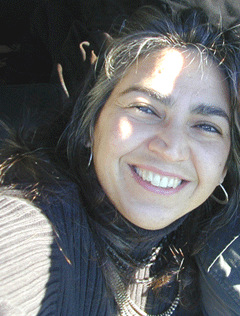
Photographer and documentary filmmaker Denise Zmekhol (Courtesy of Denise Zmekhol)
GELLERMAN: What do you want to happen as a result of your film?
ZMEKHOL: Oh, I’d just, I’d like to contribute to this change in the consciousness. And I think it’s a moment that we all have to think that we’re living on the same planet and the planet is at high risk. I think it’s all so much related that we can’t just give our backs and think “wow, this is not going to affect me.” It is already affecting us all.
GELLERMAN: Denise, thank you very much.
ZMEKHOL: Oh, thank so much. It was very nice talking to you.
GELLERMAN: Brazilian filmmaker Denise Zmekhol’s documentary “Children of the Amazon” will be shown next year on PBS. You can find a link to the director’s Web site at LOE dot org.
[MUSIC: Milton Nascimento “Me Deixa Em Paz,” Club Da Esquina 2 (Polydor 1972)]
Related links:
- Filmmaker Denise Zmekhol’s Website
- Amazon Conservation Team
GELLERMAN: Just ahead the siren song of the spider.
[SPIDER VIBRATIONS]
ELIAS: One of the things about spiders and one of the reasons that I’m interested in them, is they’re kind of maters of vibration domain. The ones on webs males, for example, pluck songs to the females.
GELLERMAN: Spiderman on string bass coming up on Living on Earth.
ANNOUNCER: Support for the environmental health desk at Living on Earth comes from the Cedar Tree Foundation. Support also comes from the Richard and Rhoda Goldman Fund for coverage of population and the environment.
Music to Miss Moppet’s Ears
GELLERMAN: You’ve heard of the movie: “The Kiss of the Spider Woman,” well this is the music of the spider man.
[VIBRATION SOUNDS]
Researcher Damian Elias of the University of Toronto, uses a laser Doppler vibrometer to measure and record spiders communicating.
ELIAS: One of the things about spiders and one of the reasons that I’m interested in them, is they’re kind of maters of vibration domain. The ones on webs males, for example, pluck songs to the females.
[RYTHMIC SPIDER VIBRATIONS]
ELIAS: It really is like plucking a guitar string. But not all spiders live on webs and so a lot of other spiders they use sort of vibrations but they’re sort of vibrating on leaves or something like that, not webs.
[SPIDER VIBRATING ON LEAVES SOUNDS]
ELIAS: One of the wolf spiders that I work on make their sounds by drumming. They use the pedipalps, which are their genitalia basically, and they’re banging them against the ground in stereotype patterns. And they also use their legs so they use their pedipalps and their legs to drum this love song to females.
[WOLF SPIDER LOVE SONG]
ELIAS: Jumping spiders have these elaborate displays where they wave the different legs, they sway back and forth in a very sort of rhythmical fashion. It’s kind of like flamenco dancing I kind of see it as.
[JUMPING SPIDER THUMPING]
The surface that you heard vibrating is actually on a nylon surface, actually panty hose because it’s just easier to control than say having them vibrate on leaves or rocks or something because they can be quite complicated, the vibration characteristics of them.
I basically came to it with an interest in sensory systems and I was interested in acoustics, vibrational or hearing. And they just happen to be such charismatic creatures, I find spiders very charismatic, that as soon as I started recording from them and it ended up that not a lot of work has been done so that really quickly fed upon itself and just really became a great system to study.
[SPIDER VIBRATION MONTAGE]
GELLERMAN: Damian Elias is a researcher at the University of Toronto. Our story was produced by Jeff Rice for the Hearing Voices radio series.
Related link:
Universtity of Toronto News and Events
Living on Earth is produced by the World Media Foundation. Our crew includes Ashley Ahearn, Bobby Bascomb, Eileen Bolinsky, Ian Gray, Ingrid Lobet, Peter Thomson and Jeff Young - with help from Kelley Cronin. This week we welcome our new technical director, Jeff Turton and say adios to our super interns Lauren Cox and Amy Fish. Alison Lirish Dean composed our themes. Our Executive Producer is Steve Curwood. You can find us at LOE dot org. I’m Bruce Gellerman. Thanks for listening.
ANNOUNCER: Funding for Living on Earth comes from the National Science Foundation. Supporting coverage of emerging science and Stonyfield Farm: organic yogurt and smoothies. Stonyfield pays its farmers not to use artificial growth hormones on their cows. Details at stonyfield.com.
Support also comes from you our listeners, the Ford Foundation, the Wellborn Ecology Fund and Pax World Mutual Funds, socially and environmentally sustainable investing. Pax World: for tomorrow. On the Web at paxworld.com.
ANNOUNCER: PRI, Public Radio International.
Living on Earth wants to hear from you!
Living on Earth
62 Calef Highway, Suite 212
Lee, NH 03861
Telephone: 617-287-4121
E-mail: comments@loe.org
Newsletter [Click here]
Donate to Living on Earth!
Living on Earth is an independent media program and relies entirely on contributions from listeners and institutions supporting public service. Please donate now to preserve an independent environmental voice.
NewsletterLiving on Earth offers a weekly delivery of the show's rundown to your mailbox. Sign up for our newsletter today!
 Sailors For The Sea: Be the change you want to sea.
Sailors For The Sea: Be the change you want to sea.
 The Grantham Foundation for the Protection of the Environment: Committed to protecting and improving the health of the global environment.
The Grantham Foundation for the Protection of the Environment: Committed to protecting and improving the health of the global environment.
 Contribute to Living on Earth and receive, as our gift to you, an archival print of one of Mark Seth Lender's extraordinary wildlife photographs. Follow the link to see Mark's current collection of photographs.
Contribute to Living on Earth and receive, as our gift to you, an archival print of one of Mark Seth Lender's extraordinary wildlife photographs. Follow the link to see Mark's current collection of photographs.
 Buy a signed copy of Mark Seth Lender's book Smeagull the Seagull & support Living on Earth
Buy a signed copy of Mark Seth Lender's book Smeagull the Seagull & support Living on Earth

